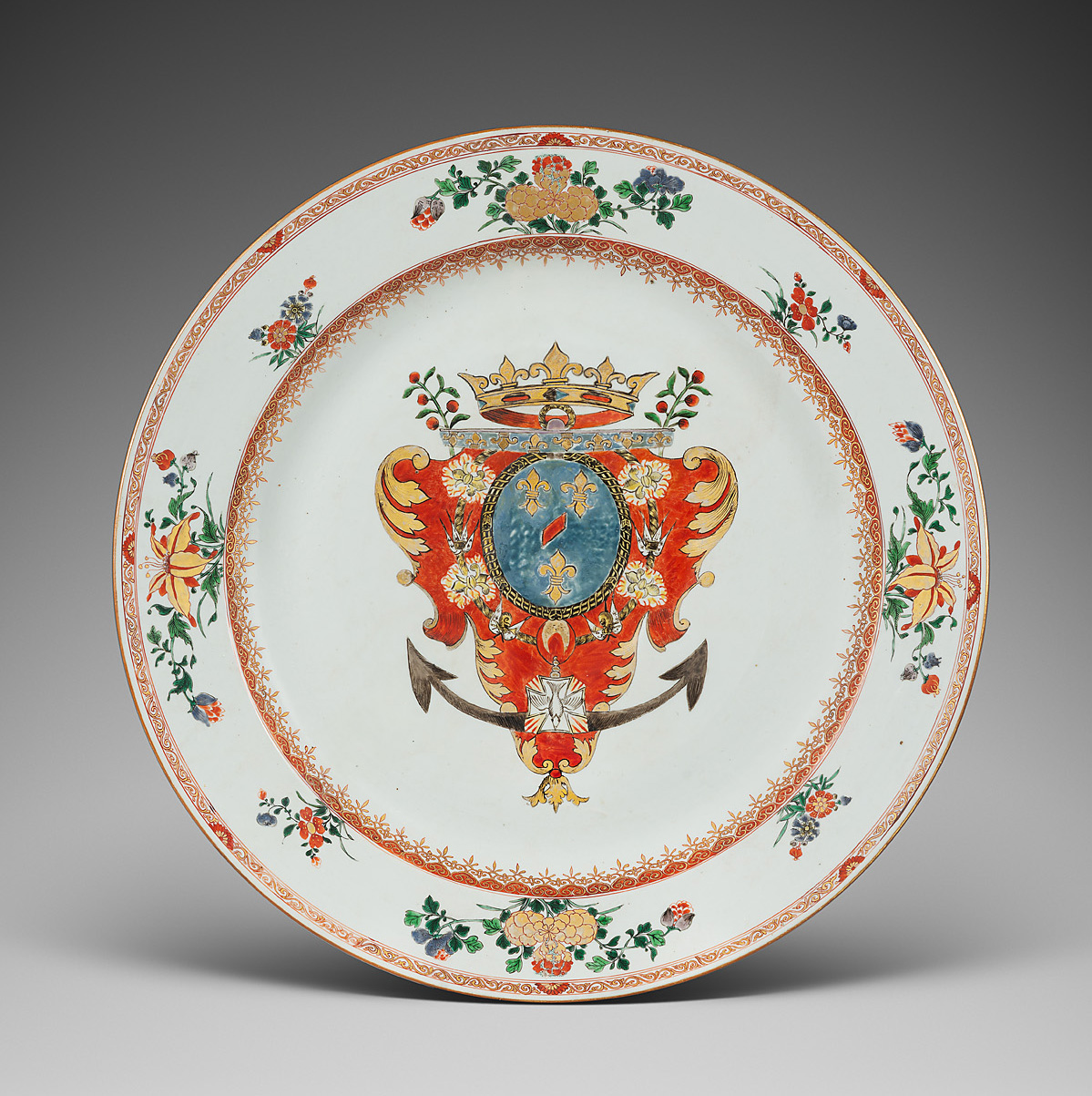Additonal informations :The order reattributed to Louis-Alexandre de Bourbon, comte de Toulouse (1678-1737), son of King Louis XIV
The current attribution to the duc de Penthièvre (1725-1793), son of the comte de Toulouse (1678-1737), is based on strict heraldic principles[1]. They stipulate that when this coat of arms is depicted with a single anchor, it indicates the rank of Grand Amiral de France ‘en survivance’ (i.e., to be inherited later). Whereas two anchors signal the rank of Grand Amiral de France. The duc de Penthièvre kept this rank from 1734 to 1737, the commission is commonly dated to that period.
However, various arguments now invalidate this attribution to the duc de Penthièvre.
Two different editions of prints of the portrait of the comte de Toulouse after Hyacinthe Rigaud (1708) contradict the rule. On these editions[2], he is represented at the same age with both versions of his coat of arms (one and two anchors). Similar parallels where the strict heraldic rule is not observed can be drawn with the silver tokens.
Photos des gravures
These massive chargers were in fashion from the late 17th to the early 18th centuries but went out of style in the 1730’s. They were only intended for ‘display,’ presented on buffets often with silverware indicating wealth, power, social status, and authority at a time when only the privileged could commission such objects from China.
Furthermore, this order is decorated in the famille verte palette, with a predominance of iron-red, once again a style more popular between 1720 and 1725 than the 1730’s. The overall decoration presents a chromatic range imitating Japanese Imari ware, with iron-red overglaze and gold accents on a distinctive underglaze blue. The frieze of fers-de-lance on the cavetto is also typical of the late Kangxi period (1662-1722).
Another argument in favor of the reattribution is that the coat of arms is surrounded by the collar of the Order of the Holy Spirit. The duc de Penthièvre was knighted in the Order of the Holy Spirit on 1st January 1742, five years after the assumed date (1734-1737) of the attribution of Antoine Lebel[3]. The comte de Toulouse was knighted in the Order of the Holy Spirit on 2 January 1693, a date that is consistent with the fact that the arms painted on the porcelain circa 1720-1725 include the collar of the Order of the Holy Spirit.
The comte de Toulouse also commissioned Delft earth ware pieces with his coat of arms. These pieces show the coat of arms bearing a single anchor and the PAK mark (for the De Grieksche A factory) used between 1701 and 1722. Another prove that the strict heraldic rule was not applied consistently.
A plate is in the collection of the Musée du Louvre[4]. Two very large chargers are in the collections of the Musée des Arts Décoratif in Paris. Two smaller chargers[5] are in private French collection.
A large charger[6] and an ewer are in the Musée de Sceaux. Another ewer is in the Musée Duca di Martina, National Museum at Villa Floridiana (Italy). A bourdaloue is in the collection of the Musée de la Compagnie des Indes (Lorient, France). A tazza (an early shape of the 18th century) is in the collection of the Metropolitan Museum of Art[7].
A small milk jug was in the Tibor collection[8]. A pair of candlesticks are in an European private collection.
The comte de Toulouse was one of the most important figures at the court of the King Louis XIV and later of Louis XV. He was made comte de Toulouse in 1681. In 1711, he was appointed Governor of Guyenne and Britanny, Lieutenant General and Admiral, Grand Hunstman. He was a very rich man. As Head of the Naval Council under Louis XV, he had his portrait painted by Hyacinthe Rigaud around 1708, with ships sailing on a stormy sea in the background. The comte de Toulouse lived in the Hôtel de Toulouse located near the place des Victoires (currently the Banque de France). It was one of the most important private residences in Paris at the time, he also owned the Château de Rambouillet. The comte de Toulouse was an important amateur of Chinese and Japanese porcelain. During the War of the Spanish Succession (1701-1714), he was sent to defend Sicily. In 1704, off the coast of Malaga, the fleet under his command inflicted heavy losses on the Anglo-Dutch fleet led by Admiral George Rooke. His nephew, King Philip V of Spain, then appointed him a Knight of the Order of the Golden Fleece in 1704.
[1] Antoine Lebel, Armoiries Françaises et Suisses sur la Porcelaine de Chine au XVIIIe siècle, 2009, pp. 48-49
[2] Drevet, Pierre, 1714
[3] Armoiries françaises et suisses sur la porcelaine de Chine au XVIIIe siècle, 2009, pp. 48-49
[4] Inv. RFML.OA.2022.5.1
[5] 40 cm
[6] 2017.4.1
[7] Inv. 1987.35, Helena Woolworth McCann Collection, Purchase, Gift of Winfield Foundation, by exchange, 1987
[8] now in a private French collection
